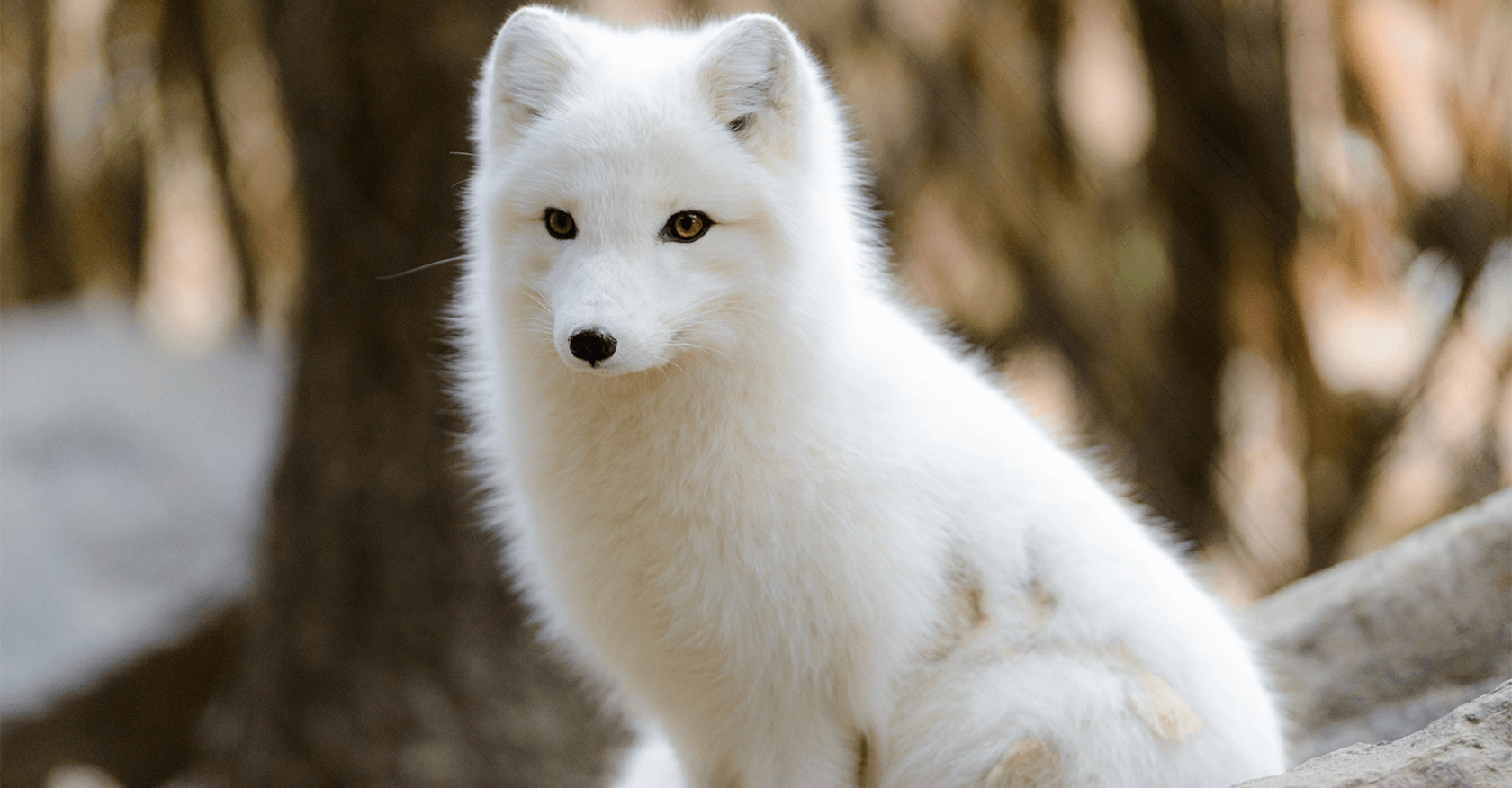Snow fox is an extremely amazing animal that can survive in extreme temperatures of -50 degrees Celsius and surrounded by no trees. They have hairy soles, ears and a short snout, which makes them best adapted to the extreme cold in the Arctic. There are many more interesting features about this lovely animal, let's find out right away in the article below!
1. Description Information
The arctic snow fox is a species of canine, carnivorous with recognizable external features such as small size, pointed ears, bushy fur, slanted eyes, and a narrow and long snout. Especially with extremely good cold tolerance, although the weather in the Arctic sometimes drops to -70 ° C, they still work without hibernation like other animals. However, in order to adapt to the harsh environment, they often dig burrows in the thick layers of snow to live and shelter in the event of a snowstorm.
Description information:
- Common name: Arctic snow fox
- Scientific name: Vulpes lagopus
- Class: Mammals
- Diet: Carnivores
- Lifestyle: Follow the herd
- Lifespan: from 3 to 6 years
- Medium size: from head to body about more than 50 cm, tail length 30 cm, height from 24-30 cm
- Average weight: about 3-7 kg
- Status in the Red Book: Species of Least Concern (symbol: LC)

2. Calculation
Snow foxes are small foxes that live in arctic tundra habitats in northern Europe, northern Asia, and North America. Those are extremely cold and harsh areas, however, snow foxes are very well adapted to this environment. The thick coat and special heat exchanger system help this species stay warm even when the temperature drops to minus 70 degrees Celsius.
Arctic foxes do not hibernate and are active year round. They store fat during the fall and sometimes increase their body weight by more than 50%. This helps insulate the body during the winter as well as an abundant source of energy when food is scarce.
They live in large burrows that do not defrost, the surface is slightly raised. It is a complex system of tunnels about 1,000 square meters (1,200 square feet) wide and often located in zigzag hills and long ridges formed by sedimentary material deposited in a formerly ice-covered region. The cave has many nooks and crannies and may have existed for decades and been used for generations by fox houses.

3. Reproduction
Arctic foxes form mating pairs during the breeding season and they will stay together to raise their young in underground burrows. The arctic fox builds and chooses the entrance to face south towards the sun, making the cave warmer. Arctic foxes prefer large, maze-like slums to hide from predators and escape quickly, especially when red foxes are in the area.
The mating season usually runs from April to May and pregnancy lasts about 52 days. On average, a litter, female foxes give birth from 5 to 8 cubs but especially can have up to 25 young. Young foxes will be cared for by both parents. Sometimes, other family members will help them with this task.
The cubs will soon leave the burrow when they are 3 or 4 weeks old and wean at 9 weeks old.

4. Meal
Arctic foxes will generally eat any small animal they find, including lemmings, hamsters, other rodents, hares, birds, eggs, and carrion. They forage on excess carrion from larger predators such as wolves or polar bears, and when food is scarce, foxes even eat their own droppings. In fox areas, lemmings are the most common prey, and a family of foxes can eat dozens of lemmings a day.
In some parts of Northern Canada, large numbers of seasonal migratory birds are also abundant food sources. On the coast of Iceland or other islands, the main food is also birds. During April and May, arctic foxes also hunt ringed seals while the cubs are still in the snow cave and cannot hunt for themselves. Ice fish are also part of the diet, and foxes also eat berries and seaweed, so they are considered omnivores.

5. They specialize in hunting Size
The average length from head to body of male foxes is 55 cm, with a range of 46 to 68 cm, while female foxes average 52 cm with a range of 41 to 55 cm. In some regions, there is no difference in size between males and females. The tail is about 30 cm long in both males and females. Shoulder height is about 25 to 30 cm. The average weight of male foxes is about 3.5 kg, in the 3.2 to 9.4 kg range, while female foxes average 2.9 kg, in the 1.4 to 3.2 kg range.
With a small body size, male snow foxes weighing about 3.5kg and females 2.9kg, this species is often attacked by other predators, however, their biggest threat comes from humans. . They are often hunted for their fur, which is made into luxurious coats. Due to their relatively high fertility, the snow fox is generally not threatened with extinction. In the wild, they have an average lifespan of 3-6 years.bird eggs of all kinds, except for the eggs of the largest birds in the tundra. When there is excess food, foxes will bury the leftovers for storage.

6. Distribution and habitat
Snow foxes are distributed near the poles and live in arctic tundra environments in northern Europe, northern Asia and North America. Range includes Greenland, Iceland, Fennoscandia, Svalbard, Jan Mayen several other islands in the Barents Sea, northern Russia, many islands in the Bering Sea, Alaska and Canada as far south as Hudson Bay. In the late nineteenth century, was introduced to the Aleutian Islands southwest of Alaska.
Foxes mainly live in tundra and icebergs but are also present in the taiga in Canada and the Kenai Peninsula in Alaska. They are found up to 3,000 m (9,800 ft) above sea level and have been seen on sea ice close to the North Pole.
The Arctic fox is the only mammal native to Iceland. The species that came to island isolation in the North Atlantic ended the last ice age, crossing the frozen sea. The Arctic Fox Center at Súðavík houses an exhibition on snow foxes and conducts research into the effects of tourism on numbers. The species range during the late glacial period was wider than it is today, and fossil remains of snow foxes are found in northern Europe and Siberia.

7. How to hunt
The snow fox has a very unique hunting technique, when the prey is located, the snow fox jumps high in the air and then plunges its head into the snow. An effective move that helps it catch prey hiding under the dense snow.
A sharp, perfect sense of smell and hearing are no small factors that help the snow fox in its hunt, it can hear the mouse burrowing under the 12cm thick snow or smell the food left by a polar bear. at a distance of up to 40 km.
During harsh winters, snow foxes can travel up to 100 kilometers in search of food. They are omnivores, eating almost everything they can find, from rats, seals, fish, seabirds to berries, seaweed, insects and the leftovers of other species.
8. Adaptability

Arctic foxes live in extremely cold places on the planet but remain unshakable until temperatures drop to −70 °C (−94 °F). Adapting them to survive in the cold is their thick, layered and highly insulated coat,[8][9] a reverse heat exchange system in the circulating blood in the feet that helps maintain the temperature. body core, and is a good source of fat.
This fox has a low surface area to volume ratio thanks to its muscular body, short snout and legs, and short, thick ears. Less surface area exposed to the arctic cold means less heat is transferred from the body to the air.
The fur growing on the soles of the feet helps insulate heat as well as walking on ice. Arctic foxes have extremely sensitive hearing to pinpoint where small animals are moving under the snow. When grasping the position of the prey, will rush and pounce on the victim through the snow. Feathers change color with the seasons: most will be white in winter to hide under the snow while in summer will be gray - brown or dark brown.
However, in some populations, some individuals will occasionally have grayish-green fur in winter and become lighter in summer.
9. Conservation status

The conservation status of this fox is generally good and there are an estimated few thousand individuals in total. The IUCN classifies it as a "species of least concern". However, populations on the Scandinavian continent are endangered, despite being legally protected from hunting and persecution for decades. It is estimated that the number of adult foxes in all of Norway, Sweden and Finland is less than 200 individuals.
Snow fox abundance tends to fluctuate over a cycle with the number of lemmings and hamsters (a 3- to 4-year cycle). may be particularly vulnerable over the years as prey numbers decline, and uncontrolled predation virtually eliminates two subspecies.
The fox skin has a dark blue-gray color - an expression of a recessive gene - is particularly valuable. They were transported to various locations before the Aleutian wild foxes in the 1920s. The program was successful in increasing the number of blue foxes, but the Aleutian Canadian geese preyed on the species' conservation goals. fox.
The snow fox disappeared in the land of the larger red fox. This has been attributed to climate change - the camouflage value of bright plumage drops dramatically when there is little snow cover. Red foxes dominate when ranges begin to overlap by killing snow foxes and their young. Another explanation for the increase in red foxes is related to gray wolves: In the past, wolves kept red fox populations down, but gray wolves were hunted to near extinction in many previous ranges, numbers Red foxes grew larger, and they became the top predators of the ecosystem. In northern Europe, there are programs that allow hunting of red foxes in the former snow fox's range.
World numbers are not threatened, but two groups of snow fox populations are present. One is on Medny Island (Commander Islands, Russia), about 85-90% reduction, about 90 animal species, as a result of scabies caused by ear mites imported from dogs in the 1970s. are currently being treated with antiparasitic drugs, but results are uncertain.
The other threatened population is one in Fennoscandia (Norway, Sweden, Finland and the Kola Peninsula). This number plummeted beginning in the 20th century as a result of extremely high prices for fox fur, which caused widespread hunting and reduced populations. Snow foxes are classified as a "forbidden alien" under substance-prohibition laws. New Zealand's 1996 toxic and alien species to prevent foxes from entering the country.
10. Some interesting facts about the Arctic Snow Fox you may not know:

Snow fox has a talent for stealing goose eggs from the nest
At an altitude of over 3,000 m above sea level, the Snow Fox is still operating normally
The number of Snow Foxes to date is only a few thousand, but some areas have declared the Snow Fox to be extinct in their area.
The Cave of the Digging Snow Fox is a complex architectural system that can be about 1000 square meters long. These burrows can be passed down through different generations of foxes.
The snow fox has a unique move that helps it hunt prey hidden under the thick snow
Through the article, I have provided specifically about the interesting things of the snow fox. Hopefully, the above information will help you know more useful and interesting information about the animal world.






